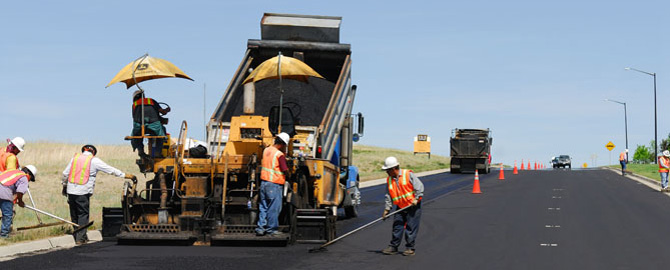
New Development and Repair
R&R
Colorado is especially hard on asphalt. Our freeze/Thaw pattern would turn Disneyworld into rubble in less than 5 years. In our 34 years in business, we have observed that asphalt paving will last up to 15-18 years in Colorado, depending on the depth and how hard the earth is under the paving. At that time, rejuvenation could be anything from crack seal and seal coat to a complete tear out. R&R stands for “Remove and Replace”. Typically, if the asphalt is cracked and able to rock back and forth in place, it is beyond being able to be fixed and must be torn out. This is the farthest that asphalt can deteriorate and beyond that, it becomes a liability issue due to open holes in the lot. R&R can be performed by conventional methods, with loaders or by Milling (See Milling).
Overlay
Overlay is pretty much self-explanatory. The old surface is cleaned and possibly crack sealed. An adhesive is sprayed on (Tack Coat) and a new layer of hot asphalt is applied and rolled in place. If the existing asphalt surface is solid, and the new height won’t adversely affect drainage, this is a relatively inexpensive route in maintaining your lot. (See Petromat)
Patching
Patching is an ongoing procedure in any preventative maintenance schedule. When done properly, all loose material is removed. The edges are tack coated and the hole is filled with hot asphalt and compacted. If removing the patch to solid edging is not possible, the repair will not last as long. (See crack seal)
Drainage Solutions
The elimination of standing water on your asphalt lot is critical in realizing the maximum lifespan of your paving. Nearly every paving company will only guarantee drainage when the slope of the asphalt is 1.5% or greater. 1.5% means that for every 100 horizontal inches, the lot will drop 1.5”. If 1.5% slope is not possible, the next best solution is to have it sit in a concrete pan. Concrete will not be as adversely affected by standing water as asphalt. Remember, flow is ALWAYS BETTER over the surface as opposed to inside a pipe unless it is below the frost line (Around 4’). We have performed drainage solutions in the most demanding circumstances where the water was directed into a cistern and then pumped off the property.
Crack Seal
One thing that is for certain is that asphalt and concrete WILL CRACK. Whether it is the Colorado freeze/thaw cycle, our native bentonite clay soil or the fault line running through the state, commonly referred to as the Rocky Mountains—Your asphalt or concrete paving will crack. Crack seal is a low-cost preventative maintenance tool that will help prevent water from getting below the pavement. This should be in every yearly property maintenance schedule. Crack seal is designed for single cracks up to ¾” thick. Beyond that is beyond manufacturer recommendations. Wide cracks should be routed or milled out and filled with hot asphalt. There are other materials used for wide cracks, such as “poly-patch” but they are costly and not widely used. Crack seal is not designed for areas of asphalt that are “alligatored”.
Petromat
Petromat is a non-woven polypropylene fabric. It is designed to help distribute weight over a larger area. Typically, if your lot is cracked but not moving, petromat will help extend an overlays life span. It is not a cure-all or a miracle. Your lot will crack even with petromat. If the existing surface is moving, petromat will not help at all.
